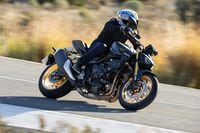Globalization has already turned auto manufacturing upside-down. America’s Big Three all assemble vehicles in Mexico and Canada, while Honda, Nissan and Toyota build the bulk of their trucks (and many cars) on American soil, creating a bizarre scenario where Japanese brands are sometimes the more patriotic choice. Though few realize it, the situation in the motorcycle industry is almost as mixed-up. Familiar motorcycles are increasingly manufactured in unfamiliar places, as harsh economic realities, just-in-time production demands and byzantine import regulations drive manufacturers to relocate production facilities to far-flung places in order to cut costs.
Ducati and MV Agusta—two of our industry’s most fiercely nationalistic brands—recently announced intentions to establish operations outside Italy: Ducati in Thailand and MV Agusta in Brazil. Both facilities will build complete-knock-down (CKD) kits—bikes manufactured in Italy but assembled in the destination market to avoid massive import tariffs that in some cases can more than double the price of a complete bike. Harley-Davidson similarly uses CKD assembly to make its American-made products more accessible to buyers in the emergent markets of Brazil and India.
Ducati is just the latest OEM to open shop in Thailand. Lower costs, high production quality and more efficient delivery to India, Africa and Europe are fast making Thailand not just an assembler, but also a top manufacturer of streetbikes. The newly released Honda CBR250R is made in Thailand, along with Kawasaki’s Ninja 250R, Ninja 650R and its derivatives, and the KLR650. Triumph is also active in Thailand, currently operating three manufacturing facilities there in addition to its two UK factories. The British firm opened its first Thai factory in 2002 as a lower-cost sourcing base for frames, fuel tanks, engine covers and other major components. A second facility, housing a wet painting facility and assembly line, was opened in ’06, followed by the third in ’07. These three operations now employ more than 800 persons, manufacturing primarily Bonneville twins and 675 triples.
BMW has likewise embraced global production. The Bavarian brand builds select 650cc and 800cc machines exclusively for the Brazilian market in Brazil, and also has a relationship with Taiwanese manufacturer Kymco to supply the single-cylinder BMW/Husqvarna 450cc enduro engines. BMW General Director Hendrik von Kuenheim told Motorcyclist's European Correspondent Alan Cathcart earlier this year that the company might also consider locating some motorcycle production in India, where the firm already builds automobiles for the Asian market. German production is important on high-end BMW models, he said, but India could be acceptable for more price-sensitive products from BMW's resurgent Husqvarna subsidiary. It's worth noting that BMW's Austrian neighbor, KTM, is 40 percent owned by India's Bajaj Motors, and its new 125 Duke is entirely manufactured on the Indian subcontinent.
This rapid rise of operations in Asia and Latin America comes on the heels of Honda and Kawasaki discontinuing motorcycle production in America, pointing to the increased importance of these emerging markets and a decline in American influence. Honda ended an era in ’09 when it ceased motorcycle production at its Marysville, Ohio, plant. Opened in 1979, the Marysville factory turned out as many as 50,000 bikes—mostly Gold Wings and cruisers intended for American buyers—annually at its peak. Kawasaki also ceased cruiser and touring-bike production at its Lincoln, Nebraska and Maryville, Missouri plants in ’06, to make room for increased ATV production capacity. Both brands build nearly all of their ATV products in America—as do Yamaha and Suzuki—reflecting the fact that the vast majority of global ATV sales are to this country. All motorcycle production has been transferred back to the home countries, leaving Harley-Davidson and Victory as the only truly American-made motorcycles.
Global production realities make it increasingly difficult to say where any motorcycle is made today—especially since American Harley-Davidsons, British Triumphs and Italian Ducatis all use suspension, electronics, brakes and other components that come from a constantly changing lineup of suppliers around the world. And it’s ultimately irrelevant, as newly built production facilities in the developing world are more modern and sophisticated than existing facilities in America, Europe or Japan, and usually monitored by on-site quality-control managers employed by the OEMs. From an enthusiast’s perspective, nearly every motorcycle is better built, better performing and a better value than at any point in recent history—no matter what the country of origin.















/cloudfront-us-east-1.images.arcpublishing.com/octane/OKWOJWAKP5EP3OACCRRWPCIX2Q.jpg)
/cloudfront-us-east-1.images.arcpublishing.com/octane/2WF3SCE3NFBQXLDNJM7KMXA45E.jpg)
/cloudfront-us-east-1.images.arcpublishing.com/octane/G4MG6OUCJNBSHIS2MVVOTPX65E.jpg)
/cloudfront-us-east-1.images.arcpublishing.com/octane/IIGGWFOTOJGB7DB6DGBXCCMTDY.jpg)
/cloudfront-us-east-1.images.arcpublishing.com/octane/QSTCM6AVEZA5JJBUXNIQ3DSOF4.jpg)
/cloudfront-us-east-1.images.arcpublishing.com/octane/U4I7G625B5DMLF2DVIJDFZVV6M.jpg)
/cloudfront-us-east-1.images.arcpublishing.com/octane/B6XD6LS6IVCQPIU6HXDJSM3FHY.jpg)
/cloudfront-us-east-1.images.arcpublishing.com/octane/ICL63FEDDRDTTMINYICCEYGMDA.jpg)
/cloudfront-us-east-1.images.arcpublishing.com/octane/FCGZHQXRBZFLBAPC5SDIQLVF4I.jpg)
/cloudfront-us-east-1.images.arcpublishing.com/octane/WNOB6LDOIFFHJKPSVIWDYUGOPM.jpg)

/cloudfront-us-east-1.images.arcpublishing.com/octane/X33NU3E525ECRHXLNUJN2FTRKI.jpg)
/cloudfront-us-east-1.images.arcpublishing.com/octane/6KKT5NNL2JAVBOXMZYS5ZO76YA.jpg)
/cloudfront-us-east-1.images.arcpublishing.com/octane/J5RKG5O455GMPGQRF2OG6LRT7A.jpg)
/cloudfront-us-east-1.images.arcpublishing.com/octane/GX2CIZKQVRH2TATDM26KFG2DAE.jpg)
/cloudfront-us-east-1.images.arcpublishing.com/octane/ZWIDYSAKQZHD5BHREMQILXJCGM.jpg)
/cloudfront-us-east-1.images.arcpublishing.com/octane/CYUHJZCTSJCH3MRAQEIKXK7SCQ.jpg)
/cloudfront-us-east-1.images.arcpublishing.com/octane/LKOFINY56FCXJCANJ5M7ZDQUBY.jpg)
/cloudfront-us-east-1.images.arcpublishing.com/octane/4NBPDACMWJH63JQYJVK3QRBDZI.jpg)
/cloudfront-us-east-1.images.arcpublishing.com/octane/KKHQHRR3FJGX7H2IPU6RALMWG4.jpg)

/cloudfront-us-east-1.images.arcpublishing.com/octane/5IOFS5JAE5FOXMNA23ZRAVVYUU.jpg)
/cloudfront-us-east-1.images.arcpublishing.com/octane/CGXQ3O2VVJF7PGTYR3QICTLDLM.jpg)
